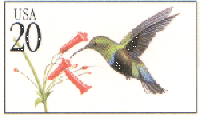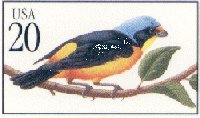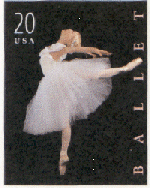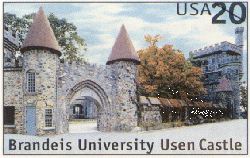United States Postal Cards
UX285 to
Present
1998
 20c Lyceum at University of Mississippi,
multicolored, lithographed, issued April 20, 1998 in University, Mississippi. Celebrating 150
years of higher education, the University of Mississippi was honored when the USPS issued a
postal card depicting the first building on its campus in Oxford, Mississippi.
20c Lyceum at University of Mississippi,
multicolored, lithographed, issued April 20, 1998 in University, Mississippi. Celebrating 150
years of higher education, the University of Mississippi was honored when the USPS issued a
postal card depicting the first building on its campus in Oxford, Mississippi.
The postal card featuring the classic Lyceum was officially dedicated in a ceremony on the
University campus in conjunction with Sesquicentennial celebrations. "Today's dedication is no
small honor. As these cards begin their journey from the university today, and from post offices all
across this land tomorrow, they will remind people everywhere of the beauty of this setting and
the necessity of preserving this country's heritage in architecture," said Postal Service District
Manager, Michael P. Jordan.
Known affectionately as Ole Miss, the University opened its doors to the first 80 students and
four faculty members on November 6, 1848 and remained Mississippi's only public institution of
higher learning for 23 years.
Located at the center of its tree-lined campus, the Lyceum was completed in 1848 and
symbolically represents Ole Miss. The building houses the university's administration offices.
Designed by architect William Nichols, whose work includes the Old State Capitol in Jackson, the
building captures the Greek Revival style of the original Lyceum near ancient Athens. It is the
only survivor of the five buildings which comprised the original campus. Based on a photo by Ole
Miss alumnus Gib Ford, the illustration is by veteran postal card and architectural artist Harry
Devlin. Twenty-seven million postal cards have been printed.
 20c Sylvester and Tweety,
multicolored, lithographed, issued April 27, 1998 in New York, New York. Sylvester & Tweety,
the frolicking feline and feather-headed canary duo of animation fame, got top billing the USPS
issued a new commemorative stamp at Warner Brothers' brand new Studio Store in Times
Square. Sylvester is the beloved Looney Tunes feline whose famous line, "Sufferin' succotash!"
has become his classic trademark. Tweety, the tiny, wide-eyed, baby-talking canary, can be
instantly recognized by his innocent "I tawt I taw a puddy tat!" just-hatched view of the world,
which makes the contradictory force of his actions hilarious. Neither malicious nor hostile,
Tweety dispatches his predators with startling speed and a wallop that surprises and delights
audiences.
20c Sylvester and Tweety,
multicolored, lithographed, issued April 27, 1998 in New York, New York. Sylvester & Tweety,
the frolicking feline and feather-headed canary duo of animation fame, got top billing the USPS
issued a new commemorative stamp at Warner Brothers' brand new Studio Store in Times
Square. Sylvester is the beloved Looney Tunes feline whose famous line, "Sufferin' succotash!"
has become his classic trademark. Tweety, the tiny, wide-eyed, baby-talking canary, can be
instantly recognized by his innocent "I tawt I taw a puddy tat!" just-hatched view of the world,
which makes the contradictory force of his actions hilarious. Neither malicious nor hostile,
Tweety dispatches his predators with startling speed and a wallop that surprises and delights
audiences.
Sylvester & Tweety, an established team, won two Academy Awards together, one for Tweetie
Pie and one for Birds Anonymous. Together and individually, Sylvester & Tweety enjoyed several
other Academy Award nominations over the years. They appeared together in more than 40
cartoons.
These post cards were sold in a booklet of 10 cards for $5.95.
 20c Girard College,
multicolored, lithographed, issued May 1, 1998 in Philadelphia, Pennsylvania. The 150th
anniversary of Girard College was officially commemorated when the USPS issued a 20-cent
postal card bearing the image of the college's Founder's Hall. The postal card is the 18th in the
Historic Preservation series honoring historic buildings listed on the National Register of Historic
Landmarks.
20c Girard College,
multicolored, lithographed, issued May 1, 1998 in Philadelphia, Pennsylvania. The 150th
anniversary of Girard College was officially commemorated when the USPS issued a 20-cent
postal card bearing the image of the college's Founder's Hall. The postal card is the 18th in the
Historic Preservation series honoring historic buildings listed on the National Register of Historic
Landmarks.
"Over 150 years ago, Stephen Girard had the vision of providing impoverished children with an
education stressing the core values of integrity, respect, compassion and self-discipline," said
Postal Governor S. David Fineman. "As a longtime resident of Philadelphia, I've grown up as an
admirer of the unique opportunity for education Girard has provided to so many young
people."
Philanthropist Stephen Girard, the college's namesake, amassed a fortune in his 81 years,
becoming the country's wealthiest citizen. Upon Girard's death in 1831, he bequeathed his entire
estate, which was then considered the nation's largest, to build and support a school for orphaned
boys. The school opened in 1848 in an era when free elementary and secondary education was
unavailable in Pennsylvania.
In 1984, the doors of the school were opened to females after 136 years of being an all-male
facility. During the past century and a half, the school has established programs that fulfill the
mission Stephen Girard chartered programs that have evolved to continuously meet the needs of a
dramatically changing society and a diverse student population.
Founder's Hall is considered one of the best examples of Greek-Revival architecture in the
country. The architect who designed Founder's Hall, Thomas Walter, was later chosen as an
architect for the United States Capitol building, designing its wings and cast iron dome.
The postal card was designed by Phil Jordan of Falls Church, Virginia, and illustrated by Tom
Engeman of San Francisco, California.
A booklet containing 4 different exotic bird postcards. Multicolored, lithographed, issued July
29, 1998 in Puerto Rico. The cards feature the Antillean Euphonia, the Green-throated Carib, the
Crested Honeycreeper, and the Cardinal Honeyeater. Two of the birds, the Antillean Euphonia
and the Green-throated Carib, are indigenous to Puerto Rico. The Antillean Euphonia is more
likely heard than seen due to its preference of the thick mountain forests of Luquillo. The
Green-throated Carib resides primarily on the northeast coast of Puerto Rico. The other two
tropical birds featured in the block of four stamps are the Crested Honeycreeper and the Cardinal
Honeyeater. The Crested Honeycreeper is an endangered species which is native to the upper rain
forests on the Hawaiian Island of Maui. The Cardinal Honeyeater is found in the small Pacific
islands of Samoa.
 20c Cardinal Honeyeater
20c Cardinal Honeyeater
 20c Green-throated Carib
20c Green-throated Carib
 20c Crested Honeycreeper
20c Crested Honeycreeper
 20c Antillean Euphonia
20c Antillean Euphonia
 20c Ballet,
multicolored, lithographed, issued September 16, 1998 in New York City, New York. Peter
Martins, Ballet Master in Chief of New York City Ballet, dedicated this stamp and postcard at the
New York State Theater at Lincoln Center. The dedication was held in conjunction with
ceremonies celebrating the 50th anniversary of the New York City Ballet.
20c Ballet,
multicolored, lithographed, issued September 16, 1998 in New York City, New York. Peter
Martins, Ballet Master in Chief of New York City Ballet, dedicated this stamp and postcard at the
New York State Theater at Lincoln Center. The dedication was held in conjunction with
ceremonies celebrating the 50th anniversary of the New York City Ballet.
"Embarking on our fifth decade, New York City Ballet always believed in taking chances,
discovering new things about ourselves, and being innovative," said Martins. "I
believe it is through this innovation that we have added something uniquely American to the
proud heritage of classical dance."
The image portrays a ballerina dressed in white, performing the step "en pointe" in an
"attitude derriere" pose on a black background, with the word
"BALLET" in pink printed down the right side. Long time stamp designer Derry
Noyes of Washington, D.C., created the stamp image based on a photograph taken by Philip
Channing of Santa Barbara, CA. The design is based on a photograph that has been digitally
altered and computer enhanced.
New York City Ballet, established in 1948 under the leadership of George Balanchine, Lincoln
Kirstein, Jerome Robbins and now Peter Martins, has continued to expand its field of influence.
The Ballet Company performs for over 650,000 individuals through a minimum of 26 weeks of
performances at the New York State Theater, at the Saratoga Performing Arts Center in upstate
New York and on annual tours.
 20c Kerr Hall, Northeastern University, multicolored,
lithographed, issued October 3, 1998 in Boston, Massachusetts. The postcard that was issued is
different than the one that was advertised in the USPS publications. The advertised postcard
showed a different view of Kerr Hall.
20c Kerr Hall, Northeastern University, multicolored,
lithographed, issued October 3, 1998 in Boston, Massachusetts. The postcard that was issued is
different than the one that was advertised in the USPS publications. The advertised postcard
showed a different view of Kerr Hall.
The 100th anniversary of Northeastern University was honored at an on-campus ceremony in
Boston, Massachusetts. "The Postal Service is proud to participate in Northeastern
University's centennial celebration," said Postmaster General William Henderson.
"Northeastern joins other notable institutions whose beautiful architecture and dedication to
higher learning have been commemorated on U.S. postal cards."
The latest addition to the Historic Preservation series, the 20-cent Northeastern University Postal
Card was dedicated on the steps of Churchill Hall. Designed by Richard Sheaff of Scottsdale,
Arizona, and illustrated by Tom Engeman, of San Francisco, California, the postal card features a
stylized detail of Kerr Hall, a residence hall recently inducted into the National Register of
Historic Places. Kerr Hall represented early efforts to promote the welfare of women in society by
making it possible for them to pursue higher education in a safe and healthful environment within
the city.
On Oct. 3, 1898, Robert Gray Dodge convened the first class of the Department of Law of the
Boston Young Men's Christian Association (YMCA). The new program was an immediate
success and marked a new phase in the YMCA and the birth of Northeastern University. In
recognition of the growth of academic programs, Northeastern College was incorporated in 1916.
By 1935, the College of Liberal Arts was added, and two years later, the Northeastern University
Corporation was established. In 1948, a revision of the University Charter and Bylaws made
Northeastern completely separate from the YMCA. Today, Northeastern is considered one of
America's greatest universities.
 20c Brandeis University, Usen Castle, multicolored,
lithographed, issued October 17, 1998 in Waltham, Massachusetts, on the 50th anniversary of
Brandeis University.
20c Brandeis University, Usen Castle, multicolored,
lithographed, issued October 17, 1998 in Waltham, Massachusetts, on the 50th anniversary of
Brandeis University.
"Brandeis University's long history of educational excellence is perhaps best symbolized by
Usen Castle, the unique landmark depicted on the postal card," said Boston Postmaster John
W. Powers III. "The Postal Service is pleased to salute the 50th anniversary of this fine
institution of higher learning."
The latest addition to the Historic Preservation series, the 20-cent Brandeis University Postal
Card was designed by Richard Sheaff of Scottsdale, Ariz., and features a photograph of Usen
Castle by Julian Brown of Boston. The castle was built of colonial fieldstone between 1928 and
1940, and now serves as an undergraduate residence hall. It was added to the National Register
of Historic Places in 1979.
Brandeis is the youngest private research university in the country. Founded in 1948, the
university is named for the late Louis Dembitz Brandeis, an associate justice of the United States
Supreme Court, and reflects the ideals of academic excellence and social justice he personified.
Coeducational classes began on the site of the former Middlesex University with 107 students and
13 faculty members.
Guided for 20 years by its founding President, Abram L. Sachar, Brandeis grew quickly,
establishing itself as an important national and international center for teaching and research. In
1961, only 13 years after the university's founding, Phi Beta Kappa accreditation was conferred.
Under each succeeding president, the university continued to grow in breadth and stature, while
maintaining the very human scale of its educational environment and its solid liberal arts focus. In
1985 Brandeis was elected to membership in the Association of American Universities, which
represents the 59 leading research universities in the United States and Canada.






Comments to Webmaster
Copyright 1998 by Martin
Peterson.
 20c Lyceum at University of Mississippi,
multicolored, lithographed, issued April 20, 1998 in University, Mississippi. Celebrating 150
years of higher education, the University of Mississippi was honored when the USPS issued a
postal card depicting the first building on its campus in Oxford, Mississippi.
20c Lyceum at University of Mississippi,
multicolored, lithographed, issued April 20, 1998 in University, Mississippi. Celebrating 150
years of higher education, the University of Mississippi was honored when the USPS issued a
postal card depicting the first building on its campus in Oxford, Mississippi. 20c Sylvester and Tweety,
multicolored, lithographed, issued April 27, 1998 in New York, New York. Sylvester & Tweety,
the frolicking feline and feather-headed canary duo of animation fame, got top billing the USPS
issued a new commemorative stamp at Warner Brothers' brand new Studio Store in Times
Square. Sylvester is the beloved Looney Tunes feline whose famous line, "Sufferin' succotash!"
has become his classic trademark. Tweety, the tiny, wide-eyed, baby-talking canary, can be
instantly recognized by his innocent "I tawt I taw a puddy tat!" just-hatched view of the world,
which makes the contradictory force of his actions hilarious. Neither malicious nor hostile,
Tweety dispatches his predators with startling speed and a wallop that surprises and delights
audiences.
20c Sylvester and Tweety,
multicolored, lithographed, issued April 27, 1998 in New York, New York. Sylvester & Tweety,
the frolicking feline and feather-headed canary duo of animation fame, got top billing the USPS
issued a new commemorative stamp at Warner Brothers' brand new Studio Store in Times
Square. Sylvester is the beloved Looney Tunes feline whose famous line, "Sufferin' succotash!"
has become his classic trademark. Tweety, the tiny, wide-eyed, baby-talking canary, can be
instantly recognized by his innocent "I tawt I taw a puddy tat!" just-hatched view of the world,
which makes the contradictory force of his actions hilarious. Neither malicious nor hostile,
Tweety dispatches his predators with startling speed and a wallop that surprises and delights
audiences. 20c Girard College,
multicolored, lithographed, issued May 1, 1998 in Philadelphia, Pennsylvania. The 150th
anniversary of Girard College was officially commemorated when the USPS issued a 20-cent
postal card bearing the image of the college's Founder's Hall. The postal card is the 18th in the
Historic Preservation series honoring historic buildings listed on the National Register of Historic
Landmarks.
20c Girard College,
multicolored, lithographed, issued May 1, 1998 in Philadelphia, Pennsylvania. The 150th
anniversary of Girard College was officially commemorated when the USPS issued a 20-cent
postal card bearing the image of the college's Founder's Hall. The postal card is the 18th in the
Historic Preservation series honoring historic buildings listed on the National Register of Historic
Landmarks. 20c Cardinal Honeyeater
20c Cardinal Honeyeater 20c Green-throated Carib
20c Green-throated Carib 20c Crested Honeycreeper
20c Crested Honeycreeper 20c Antillean Euphonia
20c Antillean Euphonia 20c Ballet,
multicolored, lithographed, issued September 16, 1998 in New York City, New York. Peter
Martins, Ballet Master in Chief of New York City Ballet, dedicated this stamp and postcard at the
New York State Theater at Lincoln Center. The dedication was held in conjunction with
ceremonies celebrating the 50th anniversary of the New York City Ballet.
20c Ballet,
multicolored, lithographed, issued September 16, 1998 in New York City, New York. Peter
Martins, Ballet Master in Chief of New York City Ballet, dedicated this stamp and postcard at the
New York State Theater at Lincoln Center. The dedication was held in conjunction with
ceremonies celebrating the 50th anniversary of the New York City Ballet. 20c Kerr Hall, Northeastern University, multicolored,
lithographed, issued October 3, 1998 in Boston, Massachusetts. The postcard that was issued is
different than the one that was advertised in the USPS publications. The advertised postcard
showed a different view of Kerr Hall.
20c Kerr Hall, Northeastern University, multicolored,
lithographed, issued October 3, 1998 in Boston, Massachusetts. The postcard that was issued is
different than the one that was advertised in the USPS publications. The advertised postcard
showed a different view of Kerr Hall. 20c Brandeis University, Usen Castle, multicolored,
lithographed, issued October 17, 1998 in Waltham, Massachusetts, on the 50th anniversary of
Brandeis University.
20c Brandeis University, Usen Castle, multicolored,
lithographed, issued October 17, 1998 in Waltham, Massachusetts, on the 50th anniversary of
Brandeis University.



